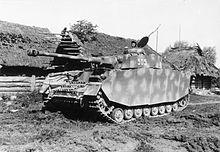| 7,5 cm KwK 40 (L/48) | |
|---|---|
 7.5 cm KwK 40 L/48 on a Panzer IV Ausf. H | |
| Type | Tank gun |
| Place of origin | Nazi Germany |
| Service history | |
| Used by | Nazi Germany |
| Wars | World War II |
| Production history | |
| Designer | Rheinmetall-Borsig AG |
| Manufacturer | Rheinmetall-Borsig AG |
| Unit cost | 13500 RM |
| Produced | 1942-45 |
| Specifications | |
| Mass | 750 kg (1,650 lb) |
| Barrel length | 361.5 cm (11 ft 10.3 in) bore (48 calibers) |
| Shell | Fixed QF 75×495mm R |
| Caliber | 75 mm (2.95 in) |
| Elevation | -10° to +20° |
| Rate of fire | 10–15 round per minute |
| Muzzle velocity | 750 m/s (2,500 ft/s) |
| Maximum firing range | 7,700 m (8,400 yd) |
The 7.5 cm KwK 40 (7.5 cm Kampfwagenkanone[a] 40) was a German 75 mm Second World War era vehicle-mounted gun, used as the primary armament of the German Panzer IV (F2 model onwards) medium tank and the Sturmgeschütz III (F model onwards) and Sturmgeschütz IV assault guns which were used as tank destroyers.
The design of the KwK 40 was adapted from the similar towed anti-tank gun, the 7.5 cm Pak 40. It replaced the 7.5 cm KwK 37 with its 24-calibre barrel, providing a huge improvement in firepower for mid-war tank designs. It came in two versions, 43 ("L/43") and 48 ("L/48") calibres long barrels, the former used during 1942 and early 1943, and the latter after that point. Along with the Pak 40, the KwK 40/StuK 40 was the most numerous anti-tank gun of the German army, and remained an effective weapon until the war's end.
Cite error: There are <ref group=lower-alpha> tags or {{efn}} templates on this page, but the references will not show without a {{reflist|group=lower-alpha}} template or {{notelist}} template (see the help page).